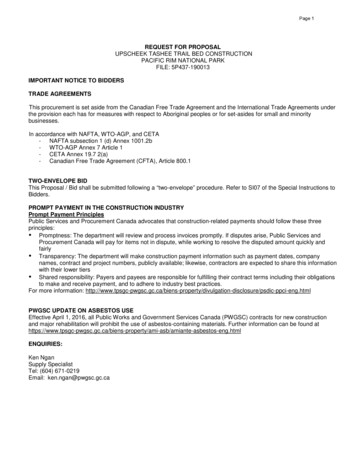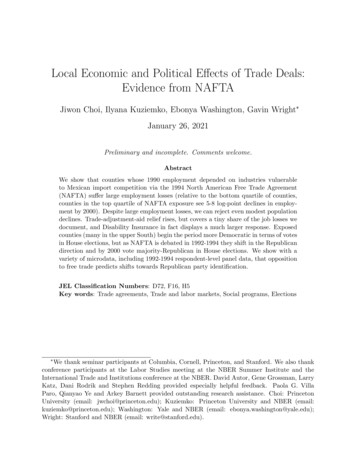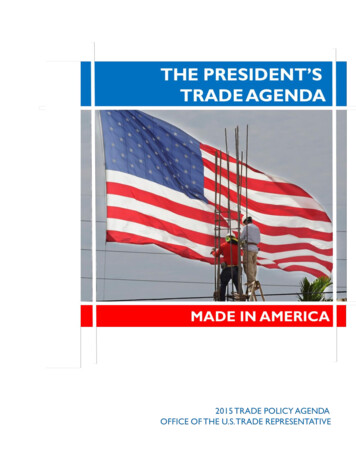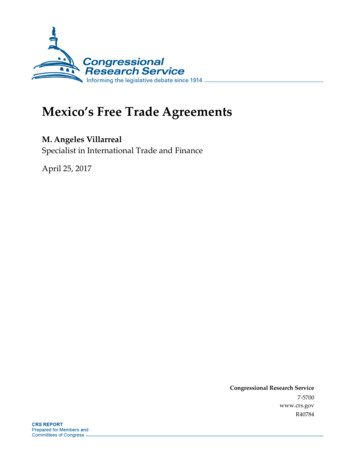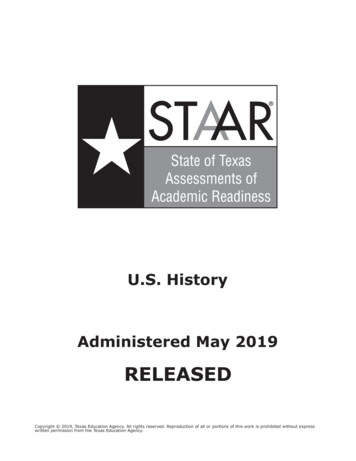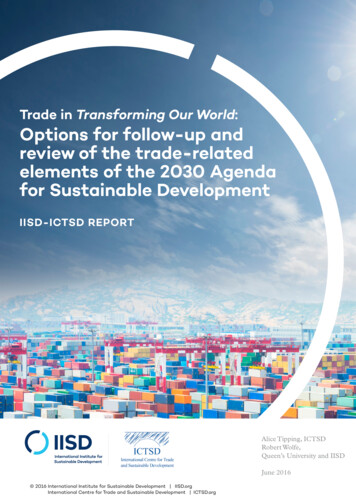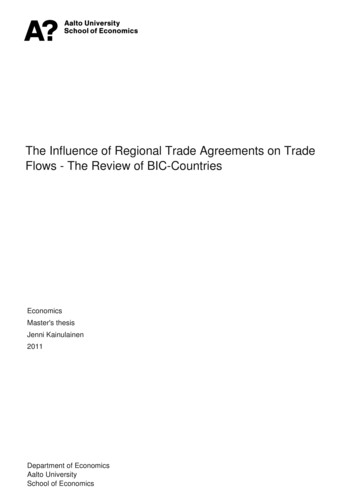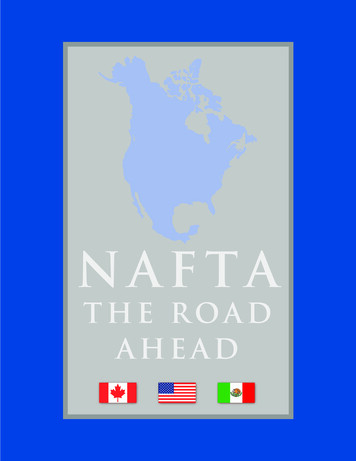
Transcription
NAFTAThe Roadahead
North America:The World’s LargestFree Trade AreaThe North American Free Trade Agreement (NAFTA) created the world’slargest free trade area, which today has 442.4 million people and acombined gross domestic product of USD 15.4 trillion. Since 1994, each ofthe NAFTA partners has experienced strong economic growth, increasedtrade and investment flows, and rising prosperity. Manufacturers, farmers,ranchers, and service providers have greater export opportunities,while consumers have enjoyed lower prices and more choices.January 1, 2008 represents an important milestone in the tradeand economic relationship between our three countries. Onthat day, the last scheduled NAFTA tariffs and quotas will beeliminated and North America will be joined in free trade.Expanding TradeBy lowering tariffs and tradebarriers, the NAFTA has bolsteredtrade among the three countries.From 1993 (the year preceding thestart of NAFTA implementation)to 2006, trade among the NAFTAcountries almost tripled, fromUSD 304 billion to USD 903billion. Each day the NAFTApartners conduct nearly USD2.5 billion in trade. The NAFTAhas also deepened businessintegration in North America.NAFTA—The Road Ahead
v Canada’s exports to its NAFTA partners increased by 173percent in value from pre-NAFTA levels. Exports to theUnited States grew from USD116.8 billion to USD316.8billion, while exports to Mexico reached USD3.9 billion.v U.S. exports to Mexico and Canada grew by 157 percent,from USD 142 .0 billion (USD 41.6 billion to Mexicoand USD 100.4 billion to Canada) to USD 364.5 billion(USD 134.2 and USD 230.3 billion, respectively).v Mexican exports to the U.S. grew by 392 percent, reachingUSD212.3 billion. Exports to Canada also grew substantially fromUSD1.5 to USD5.2 billion, an increase of almost 237 percent.A significant portion ofNorth American trade is intraindustry or intra-firm trade.An automobile in NorthAmerica might cross theborder seven times as it movesthrough the production process.NAFTA—The Road Ahead
Annual Trilateral Trade, 1994–20061000902.4900825.3800739.0681.0Billions of U.S. Investment199619971998199920002003200420052006By establishing a strong, certain, and transparent framework forinvestment, the NAFTA creates an environment of confidenceand stability required to make long-term investments. As a result,investment has poured into each of the NAFTA countries since 1994. In2006, foreign direct investment (FDI) by each of the NAFTA partnersin the other countries reached USD 533 billion, more than triple theUSD 138 billion figure registered in 1993. NAFTA has also stimulatedincreased investment from countries outside of NAFTA. In 2005,North America received USD 151.3 billion in new investment, or 17percent of the world’s total. In 2005, the current stock of FDI in NorthAmerica was USD 2.2 trillion, or 21.6 percent of the world’s total.NAFTA—The Road Ahead
ExpandingProsperity WhileEnhancing SecurityRecognizing that our economic prosperity and security must bemutually reinforcing, the Canada, Mexico and the United Stateslaunched the Security and Prosperity Partnership (SPP) in 2005. TheSPP builds upon existing trilateral mechanisms and relationshipsto enhance cooperation on issues that affect the security andprosperity of North America, and the quality of life of its citizens.The SPP initiatives form an agenda for cooperation among the threecountries of North America in areas such as combating crime andterrorism, competitiveness, and public health and safety. For example, theNAFTA Free Trade Commission manages the SPP initiative to facilitate themovement of goods. Since 2005, the NAFTA partners have implementedtwo sets of changes to liberalize the rules of origin and make it easierfor traders to qualify for duty-free treatment under the NAFTA. The totalvalue of trade covered by these changes exceeds USD 60 billion per year.NAFTA—The Road Ahead
Leaders inInternationalTradeThe NAFTA has demonstrated that trade liberalization plays an importantrole in stimulating economic growth. We reaffirm our commitment toa successful market-opening outcome for the World Trade OrganizationDoha Development Agenda, one that spurs meaningful new tradeflows, economic growth and development. At the regional level, ourvision remains of the hemisphere in a Free Trade Area of the Americas.At the bilateral level, each of our countries has built on the NAFTAexperience to negotiate additional free trade agreements. Since 1994:v Canada has free trade agreements with Israel, Chile, and CostaRica, and has concluded free trade agreement negotiations withthe members countries of the European Free Trade Association(EFTA: Iceland, Liechtenstein, Norway and Switzerland).Canada is currently in the process of negotiating free tradeagreements with four countries in Central America (El Salvador,Guatemala, Honduras and Nicaragua), Singapore, Korea, andhas recently launched free trade agreement negotiations withthe Andean Community countries of Colombia and Peru, theDominican Republic and the Caribbean Community (CARICOM).v The United States has free trade agreements with Jordan, Chile,Singapore, Australia, Morocco, Bahrain, the Dominican Republicand five countries in Central America (CAFTA-DR: Costa Rica, ElSalvador, Guatemala, Honduras and Nicaragua. Costa Rica hasnot yet ratified the agreement). The United States has recentlysigned free trade agreements with Peru, Colombia, Panama,and Korea, and is currently negotiating a free trade agreementwith Malaysia. The U.S.-Oman Free Trade Agreement will enterinto force upon Oman’s completion of its domestic procedures.v Mexico has concluded free trade agreements withChile, the European Union, the European Free TradeAssociation, Israel, Bolivia, Colombia, Nicaragua, theCentral America Northern Triangle (El Salvador, Guatemala,and Honduras), Costa Rica, Uruguay and Japan.NAFTA—The Road Ahead
Protecting theEnvironmentThe NAFTA partners are committed toprotecting the environment. Businessintegration has spurred betterenvironmental performance across theregion by facilitating the transfer of greentechnologies and market-based solutionsto environmental problems and, ultimately,by increasing national wealth. In addition,through the Commission for EnvironmentalCooperation (CEC), created under the NorthAmerican Agreement on EnvironmentalCooperation, the NAFTA partners have promoted policies and actions thatprovide mutual benefits for the environment, trade, and the economy.For example, the Council, the CEC’s governing body, recently welcomeddiscussions among the three governments to promote long-term competitiveness and environmental sustainability in North America. It alsosupported efforts to improve cooperation between the CEC and the FreeTrade Commission on issues concerning increased trade and improvedenvironmental performance. In addition, the CEC recently completed apilot program that helped small and medium-size businesses improveenvironmental performance, and thereby improve competitiveness.Participating businesses reported overall savings of nearly USD 2 million.The CEC is currently applying lessons learned in this program to improving the production chains in the automotive and electronics sectors, twoof the 10 most globally competitive productive sectors in North America.RespectingLabor RightsThe North American Agreement onLabor Cooperation (NAALC) adds asocial dimension to the NAFTA. Throughthe supplemental labor agreement,the NAFTA partners seek to improveworking conditions and living standardsand to promote a broad set of laborprinciples, and commit themselvesto promote compliance with andeffectively enforce their labor laws. Toaccomplish these goals, the NAALC createsmechanisms for cooperative activitiesand intergovernmental consultations,as well as for independent evaluationsand dispute settlement related to theenforcement of national labor laws.NAFTA—The Road Ahead
For more information about NAFTA, please visit our websites:Canada: http://www.nafta.gc.caUnited States: http://www.ustr.govMexico: http://www.economia.gob.mxDAVID EMERSONMinister for International Trade, CanadaSUSAN C. SCHWABUnited States Trade Representative, United States of AmericaEDUARDO SOJOSecretary of Economy, Mexico.!&4! s !,².! s 4,#!.6!.#/56%2 Trade and investment dataprovided by Canada,the United States,and Mexico.NAFTA—The Road Ahead
January 1, 2008 represents an important milestone in the trade and economic relationship between our three countries. On that day, the last scheduled NAFTA tariffs and quotas will be eliminated and North America will be joined in free trade. By lowering tariffs and trade barriers, the NAFTA has bolstered trade among the three countries.

